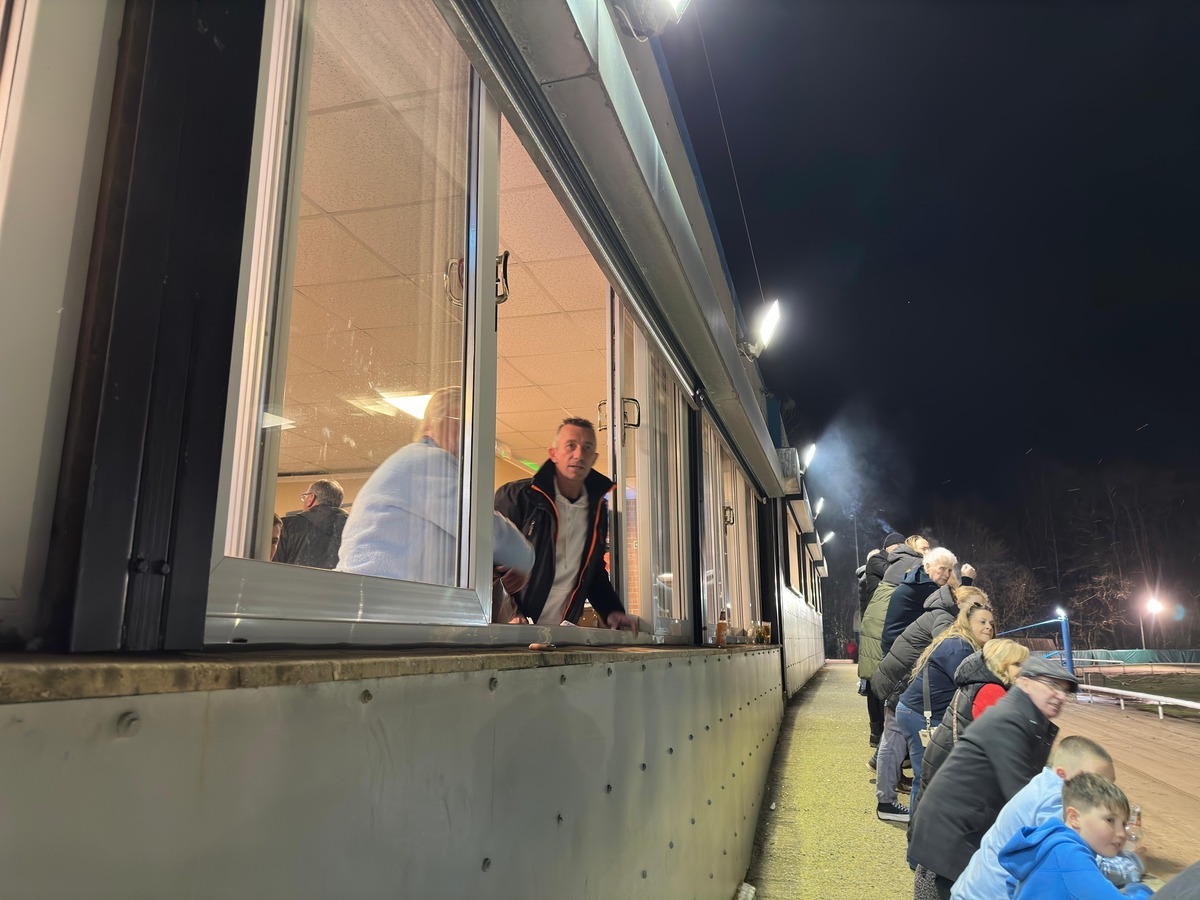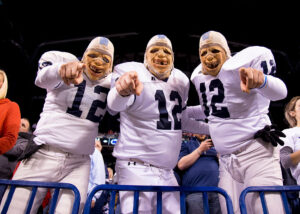Eight minutes ’til race one. The Valley Stadium is packed, a sense of nervous anticipation lingering in the air. It’s St David’s Day, and a huge crowd has flocked to Wales’s last greyhound track, in the small Valleys town of Ystrad Mynach (uh-strad muh-nack). Malcolm Tams, the 67-year-old track manager, stands quietly at the back of the clubhouse, watching it all unfold. “Just look at it,” he says with a schoolboy grin. “And they say this is a dying sport.”
Two minutes ’til race one. A rush to the bar. Hordes of children dart out to track level, bleary-eyed parents in tow. The trainers are out, the dogs at their blocks.
Race! “Go on boy!” a 10-year-old boy howls as the dogs whiz by the first bend, grains of track sand flying into the air. Cheers waft from the clubhouse. Patrons hang out the windows. Everything in the balance. The dogs cross the finish line, and the race is over, about 10 seconds after it begins. “Maybe next time, mam,” the boy says sullenly.
Order restored, punters head back to the bar, families to their tables. Some linger outside, flecked by cigarette smoke. It’s a scene trapped in time, both 1935 and 2025. Soon, though, it could all be over.
Last month, Wales’s Deputy First Minister announced the Welsh government’s plans to ban greyhound racing. Animal welfare groups were unsurprisingly delighted. “Obviously,” says Tim Doyle, CEO of Greyhound Rescue Wales, “we are very pleased.” For the Valley, though, it’s a dagger to the chest. “We learned about it after a Welsh newspaper asked us for a comment,” laments Katie Bennison, a board member of the Greyhound Board of Great Britain (GBGB).
No one truly knows why the decision came when it did. “It’s a class issue,” one Valley patron tells me, flat cap in hand, one eye on the track. Doyle disagrees. Greyhound racing, he says, has never been a working-class tradition. Others, like Tams and Bennison, blame the budget, and how the Welsh government is hellbent on pushing a half-baked policy through in time. Everyone has their theories.
Slice through the noise, though, and go to the Valley on a race night, and you’ll find more than mere discourse. You’ll find the old guard, pints of lager in hand. You’ll find Tams, who’s been coming since the track opened in 1975. He owned it until a few years ago, but still helps run things day to day. You’ll find children and families and teenagers and young adults.
Most are from the local area, though some visit from further afield. “Is it going to be banned, then?” asks one man with an undeniable Cockney drawl. He’d come from East London. “It’s a long way, but I know people here,” he says. “I used to go to the Wimbledon track but that’s long gone. It’s important to me to keep this thing alive, especially now my boys are old enough.” To show what he means, he gestures to two teenagers, clad in matching flat caps and Barbours.
People come, of course, for the dogs — but as their variety implies, they also come for something else. Maybe it’s the clubhouse, a hangover from the age of the bingo hall. The Valley’s cheap wooden chairs, with tatty blue faux-leather seats, sit by sticky wooden tables. From suspended ceiling tiles beam sickly white lights, onto a no-frills bar stocked with plenty of cheap booze. Along the walls, there are frames. They immortalise prize-winning greyhounds — with names like “Boss” and “Pandy Bow” — but could quite as easily hold the pictures of amateur boxers or rugby players.
Maybe it’s all a ruse. Proletarian chic is a big commodity these days. Norman’s Cafe, in Archway, once a fulcrum of the working classes, now serves salt-of-the-earth food at sky-high costs. Few were shocked when Burberry held a fashion pop-up there in 2023. The veil, by that point, had long since fallen.
But you only have to chat with people at the Valley to find a way of life you can’t simply mimic. This sport burrows deep. Everyone has been touched by it in some way. When they think back to that first time, their eyes come alive and their mouths twitch, and they gaze off into the distance.
Malcolm, a small man with thick-rimmed glasses, whose facial features have taken on the pointedness of the very dogs he races, had greyhounds as a youth at the Valley. He speaks in sharp, passionate bursts, so characteristic of the men of South Wales, and so hard to understand. It’s only when he veers onto the topic of greyhounds that everything becomes slow and clear. “Back in the day, they were the best,” he says. “We had Bedwellty. Forest Fach. Skewen,” listing names of former race towns that have long-since gained mythical status in greyhound circles, as if without their tracks they cease to exist.
Overhearing our conversation, another man chips in. “I’ve been coming to the greyhounds since I was a boy. I’m 70 now,” he says, his watery blue eyes shining. “My grandfather took my dad, they both took me. I took my son. Maybe I won’t be able to take my grandson.”

Next to the clubhouse, in a little office with a worn “Staff Only” sign, Lee Blankley, the racing manager, recalls his weekends in the family caravan near Leicester as a child. There, behind the town hall, men in long coats and caps raced whippets round a track. He was hooked. Now, both he and his wife work at the Valley.
Perhaps I’m being a little too romantic. For animal rights groups, it’s simple: the greedy betting industry wants to work these poor dogs to death. And there’s some truth to this. Between 200 and 300 racing greyhounds die of injuries each year in the UK. There’s also no living shortage of the barbarous ways these animals have paid for the profit and joy of others. When I meet her, Jilly, an 11-year-old former race dog at the Valley, struggles to walk the short 10 minutes to the track from the nearby park. She wasn’t unfit: she only had three legs. “She lost it on the sharp bend at the Valley,” Essex Havard, her rescuer, tells me.
No one can deny the brutality in this. In the end, though, the dogs are only part of the attraction. It’s not all nostalgia either, for the Valley clearly matters in the here and now as well.
Tams greets many punters by name as they walk through the door. I stand and watch him for five minutes and become convinced he’s hiding a cheat sheet up his sleeve. “But that’s what it’s like here,” he says. “I know these people, and they know me.” Later, at the far end of the club, I find an elderly woman who turns up every week to cook burgers squeezed inside cheap white buns. “It’s my 70th birthday today and I’m here,” she says when I ask about the track. “I think that says it all.”
In part, such richness can be understood by history. For Keith Laybourn explains, an academic who specialises in British working-class culture, greyhound racing has been popular since 1926 when, after some success at home, a few Americans and Canadians brought the concept to Britain and set up a track in Manchester. It proved a hit, offering a cheap and glamorous night out, with its bright American-style lights and fast-talking announcers.
At the same time, dog racing was also the first time working-class people could legally bet, a bonanza which by the mid century saw totalisator turnover exceed £200 million. Until then, betting behind closed doors, in pubs or on the street, was illegal. The only place it was allowed was “settings” — strongholds of the wealthy like horse racing tracks. But with the coming of the dogs, working-class communities had their own special place to have a flutter.
The popularity of the greyhound caused a fuss. Do-gooders launched a series of legal campaigns against greyhound racing, and even Winston Churchill set out to squash the new trend among working people. In 1927, he wrote a letter to the Home Secretary warning of the dangers of what he described as “animated roulette boards”.
At the time, such objections felt churlish. Now, though, it’s hard to escape the sense that greyhound racing has had its day. The times I visited the Valley, it was only truly packed on St David’s Day, a special occasion. On a Thursday, maybe 30 or 40 make the trip. The numbers are a fraction of the 70 million who attended in 1946, with the decline really starting in 1961, with the legalisation of high-street betting shops. Forget South Wales: from Aberdeen to Hackney Wick, Exeter to Northamptonshire, you could do a tour of Britain in shuttered dog sites.

There is a disconnect here, I think, one that cuts at the heart of modern Britain: how old ways co-exist with new moral codes. Is it more important to protect sentient life or to preserve a way of life? Both have beating hearts, even if the latter doesn’t bleed. And few who hate dog racing have ever been to the Valley. Senedd members did promise to come, but fewer than five actually turned up.
The sport, for its part, has tried to make racing fairer and safer. In 2007, for instance, the Greyhound Forum for Wales submitted a paper to the Welsh Assembly outlining a code of practice for greyhound racing in the nation. Many of these ideas were later taken up by GBGB, encompassing everything from monitored visits by vets to inspections of residential kennels. Once they hang up their paws, retired greyhounds must also be rehomed.
Yet despite these attempts at modernisation, Laybourn suggests the sport’s overall decline isn’t so surprising. “When it goes,” he says, “the working classes will move to another sport to bet on. We’ll collectively lose a culture, but culture is always changing.”
Ystrad Mynach knows this all too well. It was blessed by the black gold found beneath its ground in the 19th century, and soon had everything that came with a mining town: a strong union movement, social clubs, community groups. When the miners’ strike hit the Valleys in the Eighties, volunteers worked around the clock to hand out food to families in need. Their base was the Penallta Workmen’s Library and Institute, not far from where the Valley Stadium now stands.
Most of that is gone now. Like towns across Britain, Ystrad Mynach has had life sucked out of it. The high street alone is indicative of this shift. Many beautiful early 20th-century red-brick buildings stand vacant. Three high-street banks have closed, leaving many locals unable to access their cash. It’s a trend common across the country, with more than 6,000 banks closing their doors since 2015.
Telling, too, is what’s taken their place. There’s a big Tesco supermarket and a Lidl. There are two Kurdish barbers, two vapes shops and 12 takeaways. All are transactional, and do nothing to really keep Ystrad Mynach together.
None of this necessarily means the place is worse off than it once was. Though mining towns have struggled to make the transition to the post-industrial world, they’re not entirely hopeless. Doncaster, also a former mining town, employed 50% of its workers down the mines in 1931. And though, on the surface, the town appears to be in decline, today it has over double the number of jobs it did a century ago.
But economics only goes so far. These towns have lost something cultural, places to meet and share conversation. There are pubs, to be sure, rowdy spots whose names I shouldn’t share, but locals will know all too well. But drinking in Ystrad Mynach and elsewhere has lost what once made it special, with bathrooms awash with cheap cocaine and Noughties trance tunes blaring on £1 jukeboxes. That’s heaven for some, hell for most.

Where does one go, then, if you want company in Ystrad Mynach in 2025? “We go to the Valley,” one woman says, watching her seven-year-old boy following the bright lights of a TV showing replays. The Valley is warm in its shabbiness, familiar in the strange space it occupies in the 21st century. There’s no music, no shouting, no fighting. No one is seriously betting to make money. The top prize on St David’s Day was just £250, and even that was a sponsored race.
And on the contests go. Eight minutes ’til race eight. The clubhouse is rammed for the last race of the night. Katie, from GBGB, takes a position behind the bar. “In all honesty, I don’t know what will happen,” she says, between pouring pints. “We’re in limbo. The community is in limbo.”
Two minutes ’til race eight. The kids whiz past the bar and head outside, down to track level once more. Mums and dads grudgingly follow, grimacing against the cold. The older men stay at their tables. Others wait patiently, eager to put a few quid down on the dogs. Many simply stand around, chatting and laughing.
The night is almost over. The dogs are out, strolling to the stocks from where they’d start their last dance. The 10-year-old shouts again, and the fans hang out the clubhouse windows. The buzz swells, the drinkers hold their breath.
And then, the announcer: Race!
Disclaimer
Some of the posts we share are controversial and we do not necessarily agree with them in the whole extend. Sometimes we agree with the content or part of it but we do not agree with the narration or language. Nevertheless we find them somehow interesting, valuable and/or informative or we share them, because we strongly believe in freedom of speech, free press and journalism. We strongly encourage you to have a critical approach to all the content, do your own research and analysis to build your own opinion.
We would be glad to have your feedback.
Source: UnHerd Read the original article here: https://unherd.com/




